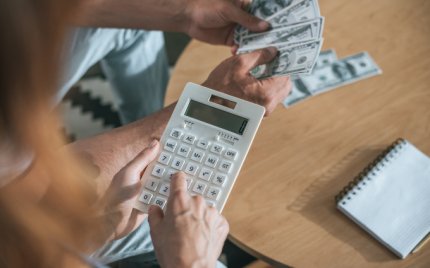Many different methods allow you to manage your budget effectively. One such way is called "50-30-20". It makes it possible to create a balance between consumption and savings to ensure a stable standard of living in the future. Guide Online tells how to plan a budget and easily save money using the "50-30-20" rule.
What does the "50-30-20" rule mean?

Photo: envato.com
The 50-30-20 rule means that all your income from different sources should be divided into three parts. At the same time, the percentage ratio looks like this:
50% – expenses for basic needs. This includes half of your monthly income, which you can spend on rent, utilities, communication services, groceries, public transportation, loan repayments, etc. That is, these are the mandatory costs.
30% — unforeseen expenses, fulfilment of wishes. This item includes fees for gifts for friends' birthdays, tickets to concerts or the cinema, hobbies, the purchase of household appliances, hairdressing services, etc.
20% is money saved. This part of your budget should be "untouchable". It can go, for example, to a bank deposit. Later, the money you have collected can be spent on buying a car or apartment, travelling or getting an education. They also create a "financial security cushion".
It should be remembered that the third part of the monthly budget should be set aside even before you start spending the first and second parts, for example, immediately after receiving a salary. It would be best to understand that the maximum is 30% for optional expenses. The less you spend, the more you can save.
How to apply the "50-30-20" rule?

Photo: envato.com
The "50-30-20" rule is simple in theory but pretty ambiguous in practice. The incomes and expenses of each family (if we are talking about the family budget) differ, as do the needs of individual members. Also, everyone has their vision of "necessary" and "secondary".
Based on this, slight deviations in the percentage ratio are allowed. For example, you can divide the budget in this way — 60-25-15. But these deviations should not be significant because there is a clear rule — you cannot transfer money from one category to another during the month.
It is also worth noting that the "50-30-20" method will be complicated for people who spend most of their budget on paying off loans or renting a house. It is not suitable for those who do not have a stable income; instead, it "interrupts" from earning to earning.
Nevertheless, the method has many advantages:
Ease of use, availability, absence of complex calculations and mathematical schemes. This method can be used by people who are just beginning to understand the laws of financial literacy.
Clearness. If you have experience managing finances, allocating sums for certain expenses on three points will not be difficult. At the same time, you will be able to "keep track" and understand whether you manage to follow the rules.
The ability to save. Using this rule, you learn to save money. Yes, if you lose your primary source of income, you can "hold out" for a specific time until you find a new job.
Thanks to the "50-30-20" rule, you will always have savings for doctor's services if you get sick or for repairing expensive household appliances that have broken down.
How to calculate a budget according to the "50-30-20" rule?

Photo: unsplash.com
Assuming you earn UAH 20,000 per month, according to the "50-30-20" rule, you will spend UAH 10,000 on essential needs. This includes food, clothing, transportation, etc. If you have to pay more than 50% of your salary for rent, you can slightly reduce the next item, which is about optional shopping and entertainment.
Try to "enter" the "main expenses" column at 50% of your income. Even if you don't "cut" the second point, you will have an average of UAH 6,000 left for leisure, gadgets, or museum trips. For the third point, you have approximately UAH 4,000. They cannot be spent without a grave reason. Later, a considerable amount will be collected from this money.

